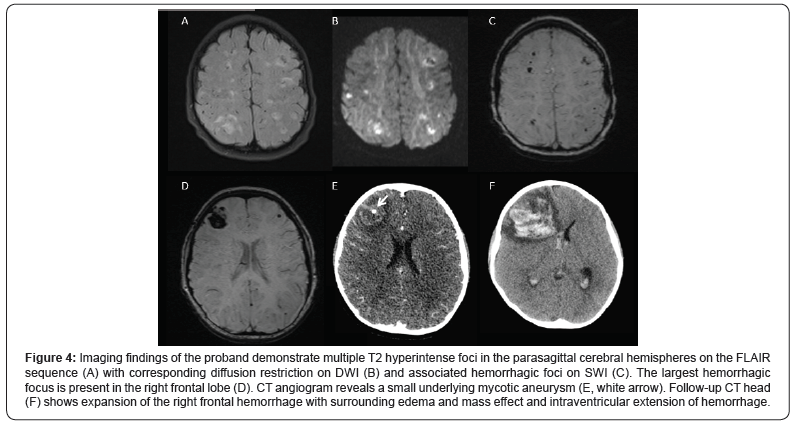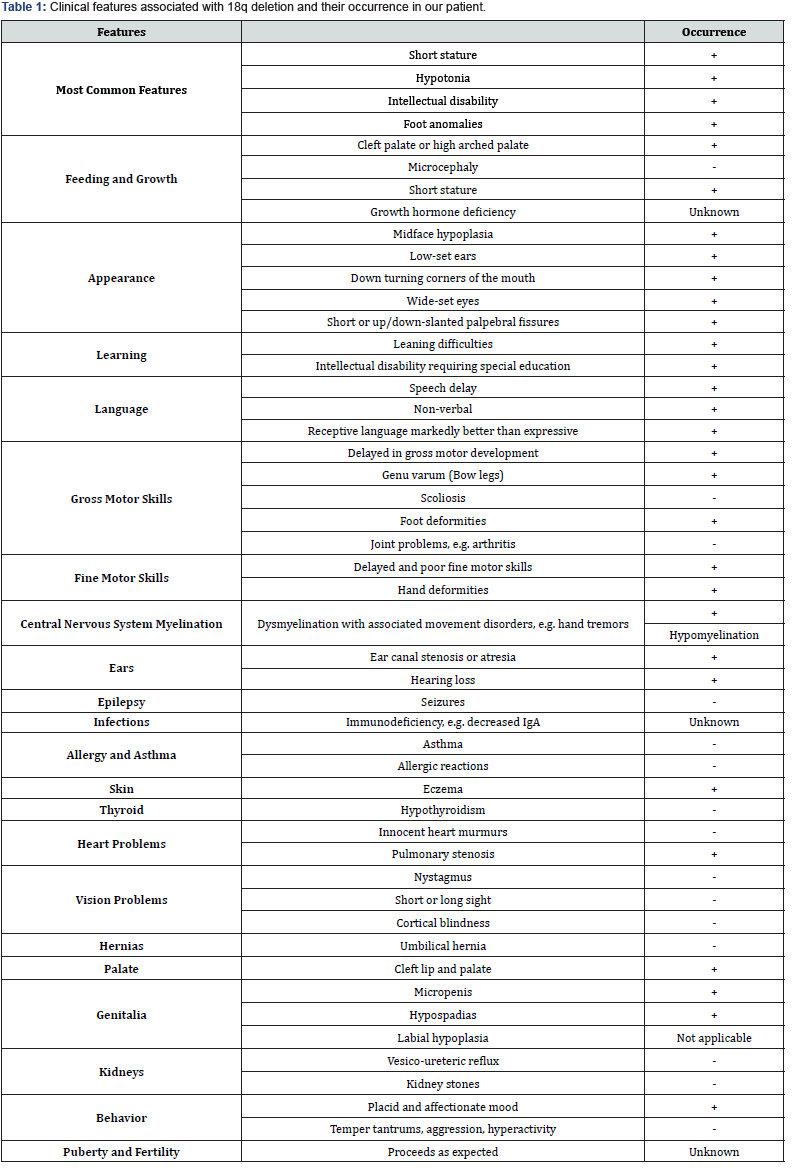Juniper Publishers- Open Access Journal of Case Studies
A Case Report of 18q Deletion Syndrome and Xq Microdeletion
Authored by Yin Liu
Abstract
Background: The differences of clinical features in 18q deletion syndrome may be explained by variations in breakpoints.
Case presentation: We report a case with a large terminal deletion of 18q and an Xq microdeletion. He carried most of the features of the 18q deletion syndrome. The genes involved in the Xq microdeletion had uncertain significance. He suffered from septic endocarditis of the mechanical mitral valve. It was notable that this patient with a complex genetic syndrome still demonstrated classic skin lesions that contributed to his diagnosis of acute endocarditis. No guidelines have been established regarding the management of anticoagulation in the setting of mycotic aneurysms from mechanical valve endocarditis. Our patient passed away from intracranial hemorrhage of the mycotic aneurysms.
Conclusions: Clinicians who familiarize themselves with the typical findings and complications of their patient’s genetic syndrome will be more likely to recognize deviations and investigate them.
Keywords: 18q deletion syndrome; Xq microdeletion; Dysmorphic features; Intellectual disability; Congenital arcade mitral valve; Septic endocarditis; Mycotic aneurysms
Background
The differences of clinical features in 18q deletion syndrome may be explained by variations in breakpoints. We report a case with a large terminal deletion of 18q and a concurrently Xq microdeletion. The patient had an unusual disease course associated with congenital cardiac abnormality. There were several points in this case that were unexpected and therefore educational.
Case Presentation
The proband was the second child of a nonconsanguineous couple. He was born at term via an uncomplicated pregnancy with a birth weight of 3628g (50th percentile). At birth, he was noted to have a cleft palate, for which received corrective surgery within the first year of life. He was also diagnosed with congenital arcade mitral valve, which resulted in severe mitral stenosis and pulmonary hypertension. He had a mitral valve replacement at 5 years of age. He also had atresia of the ear canals and sensorineural hearing loss. Developmentally, he rolled over at 9 months, sat unsupported at 11 months, walked at 4 years, and rode a bike at 8 years.
He was first seen in the genetics clinic at 10 years of age. He was in special education classes and was going into the 4th grade. A four-generation pedigree was obtained (Figure 1), which revealed no incidences of sudden cardiac death or arrhythmia. He was non-verbal but very socially engaged and prone to smiling. Clinical evaluation showed dysmorphic facial features (Figure 2). Other features not shown on the picture included repaired cleft palate with no evidence of cleft lip, absent uvula, and a tongue with an unusual central groove. He had a loud S1 from the mechanical mitral valve. There was no organomegaly. He had a small phallus and hypospadius with 2 urethral openings. The testes were descended bilaterally. He had flexion contractures in his lower extremities, especially in bilateral hamstrings and ankles. He held his hips in external rotation. He had tapered fingers with narrow nails. Supination was difficult. Eczema was present on bilateral wrist creases. The feet were small with intoeing and tight achilles tendons (Equinovarus). His muscle tone was increased, especially in the bilateral lower extremities. Reflexes were diminished but symmetric. He could not demonstrate a gait.

A SNP microarray performed in his early childhood showed Xq21.31 (87,838,375-88,164,567) x0 and 18q21.3 1q23(54,690,270-78,014,123) x1. A 23.3 mega base terminal deletion from 18q21.31 to 18q23 was observed. This deletion was also identified by metaphase FISH studies using a 18q subtelemere probe (Abbott Molecular). The deleted interval involved approximately 115 known genes and is consistent with a diagnosis of “18q- syndrome”. In addition, a 326 kilobase deletion at Xq21.31 was observed. The deleted interval includes the CPXCR1 gene. Abdominal ultrasound was essentially normal, showing normal kidneys. Orthopedic surgery diagnosed him with neuromuscular spasticity, equinovarus and cavovarus foot deformities, and tibial torsion. They recommended Botox injections, stretching, and casting. Tendon release and transfer surgeries to correct his foot deformities were also considered.
He was admitted to the hospital soon after the initial genetics visit for septic endocarditis of his mechanical mitral valve. Additional physical exam showed an extremely uncomfortable child, with flushing of his cheeks, scattered petechiae on his back, and Janeway lesions on both soles, his left index finger tip (Figure 3), and his left buttock. Trans-esophageal echocardiogram demonstrated a large vegetation on the mechanical mitral valve with associated regurgitation. He was started on appropriate antibiotics. Brain MRI showed multiple hemorrhagic bilateral cerebral infarcts concerning for septic emboli and mycotic aneurysms, confirmed on CT angiogram (Figure 4). His home Warfarin was switched to heparin continuous infusion for easy reversibility. The benefits of surgical valve replacement were felt to be outweighed by the risk of intracranial bleeding. However, during his hospitalization, he suddenly became unresponsive and an emergent head CT showed marked expansion of a right frontal hemorrhage. He passed away from cerebral herniation.

Discussion and Conclusions
Terminal deletion of the long arm of chromosome 18 is a relatively common cytogenetic abnormality, occurring incidentally in approximately 1 in 40,000 live births [1]. There have been many published cases [2-5]. Variation in breakpoints explains some of the differences in clinical features among those reports. Our patient had a large terminal deletion of 18q. Therefore, he carried most of the clinical features previously reported in this syndrome (Table 1). Deletion of the CPXCR1 gene, which our patient also had, has been studied for association with X-linked cleft palate, colorectal cancer, and uterine leiomyoma but does not currently have an established phenotype and may be benign [6-8].

Notes: These features were extracted from the brochure published by Unique, named “18q deletions: from 18q21 and beyond”.
Minor heart conditions are common in patients with 18q deletion syndrome [9]. However, congenital arcade mitral valve has not previously been reported. Pulmonary valve stenosis is also common but need for surgical repair is rare [5]. The 18q deletion syndrome is commonly listed among the causes of hypomyelination [10] although most leukodystrophies show a more severe pattern of hypomyelination. The myelin deficiency seen on our patient’s MRI was mild and patchy (not shown), in keeping with prior case reports.
Treatment of endocarditis in a patient with a mechanical valve includes antibiotics and surgical repair at an appropriate time [11]. Our patient was given appropriate antibiotics but was not able to undergo valve replacement given his high risk of complications and he died when there was expansion of the right frontal hemorrhage at the site of one of his known mycotic aneurysms. No guidelines have been established regarding the management of anticoagulation in the setting of mycotic aneurysms from mechanical valve endocarditis.
It is notable that this child with a complex genetic syndrome still demonstrated classic skin lesions that contributed to his diagnosis of acute endocarditis. Clinicians who familiarize themselves with the typical findings and complications of their patient’s genetic syndrome will be more likely to recognize deviations and investigate them.
To know more about Juniper Publishers please click on: https://juniperpublishers.com/manuscript-guidelines.php
For more articles in Open Access Journal of Case Studies please click on: https://juniperpublishers.com/jojcs/index.php



No comments:
Post a Comment